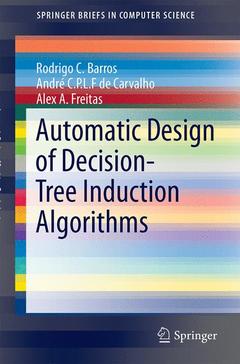Description
Automatic Design of Decision-Tree Induction Algorithms, 2015
SpringerBriefs in Computer Science Series
Authors: Barros Rodrigo C., de Carvalho André C.P.L.F, Freitas Alex A.
Language: English
Subject for Automatic Design of Decision-Tree Induction Algorithms:
Approximative price 58.01 €
In Print (Delivery period: 15 days).
Add to cart176 p. · 15.5x23.5 cm · Paperback
Description
/li>Contents
/li>Comment
/li>
Presents a detailed study of the major design components that constitute a top-down decision-tree induction algorithm, including aspects such as split criteria, stopping criteria, pruning and the approaches for dealing with missing values. Whereas the strategy still employed nowadays is to use a 'generic' decision-tree induction algorithm regardless of the data, the authors argue on the benefits that a bias-fitting strategy could bring to decision-tree induction, in which the ultimate goal is the automatic generation of a decision-tree induction algorithm tailored to the application domain of interest. For such, they discuss how one can effectively discover the most suitable set of components of decision-tree induction algorithms to deal with a wide variety of applications through the paradigm of evolutionary computation, following the emergence of a novel field called hyper-heuristics.
"Automatic Design of Decision-Tree Induction Algorithms" would be highly useful for machine learning and evolutionary computation students and researchers alike.
Introduction.- Decision-Tree Induction.- Evolutionary Algorithms and Hyper-Heuristics.- HEAD-DT: Automatic Design of Decision-Tree Algorithms.- HEAD-DT: Experimental Analysis.- HEAD-DT: Fitness Function Analysis.- Conclusions.
Provides a detailed and up-to-date view on the top-down induction of decision trees
Introduces a novel hyper-heuristic approach that is capable of automatically designing top-down decision-tree induction algorithms
Discusses two frameworks in which the hyper-heuristic can be executed in order to generate tailor-made decision-tree induction algorithms
Includes supplementary material: sn.pub/extras




